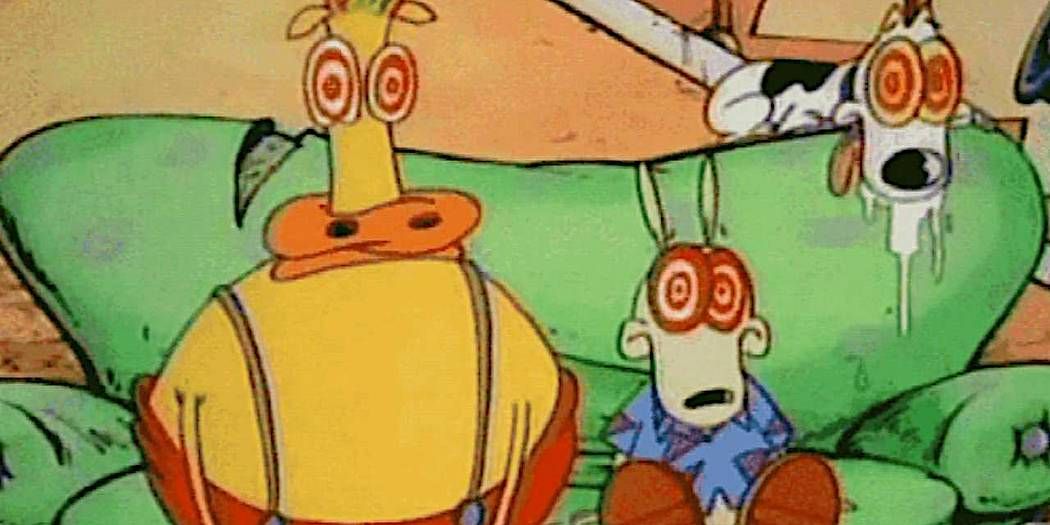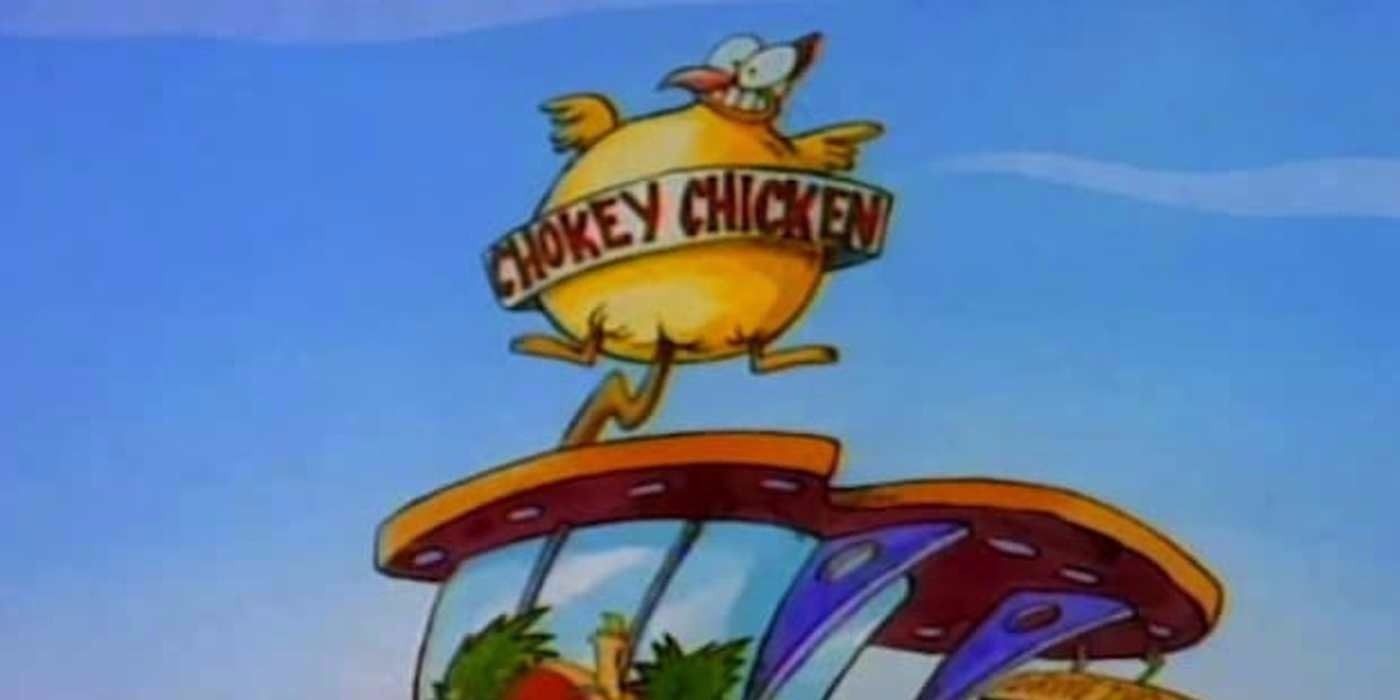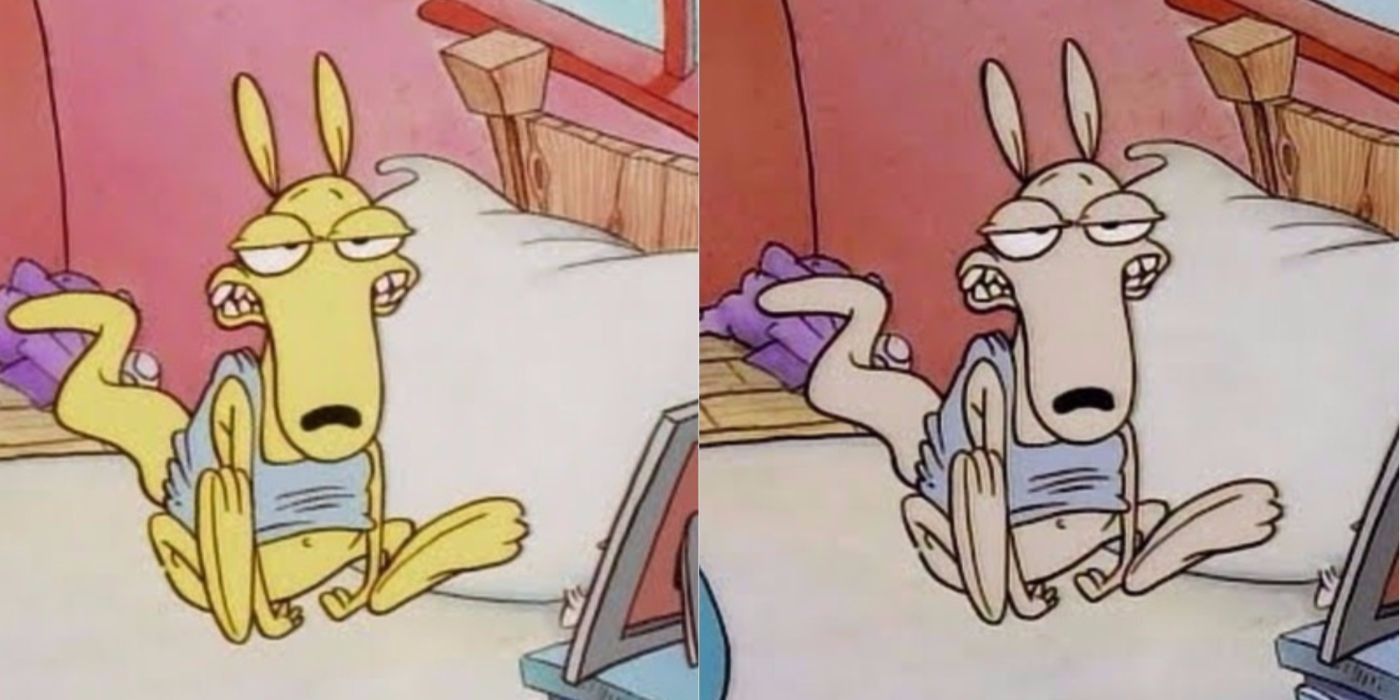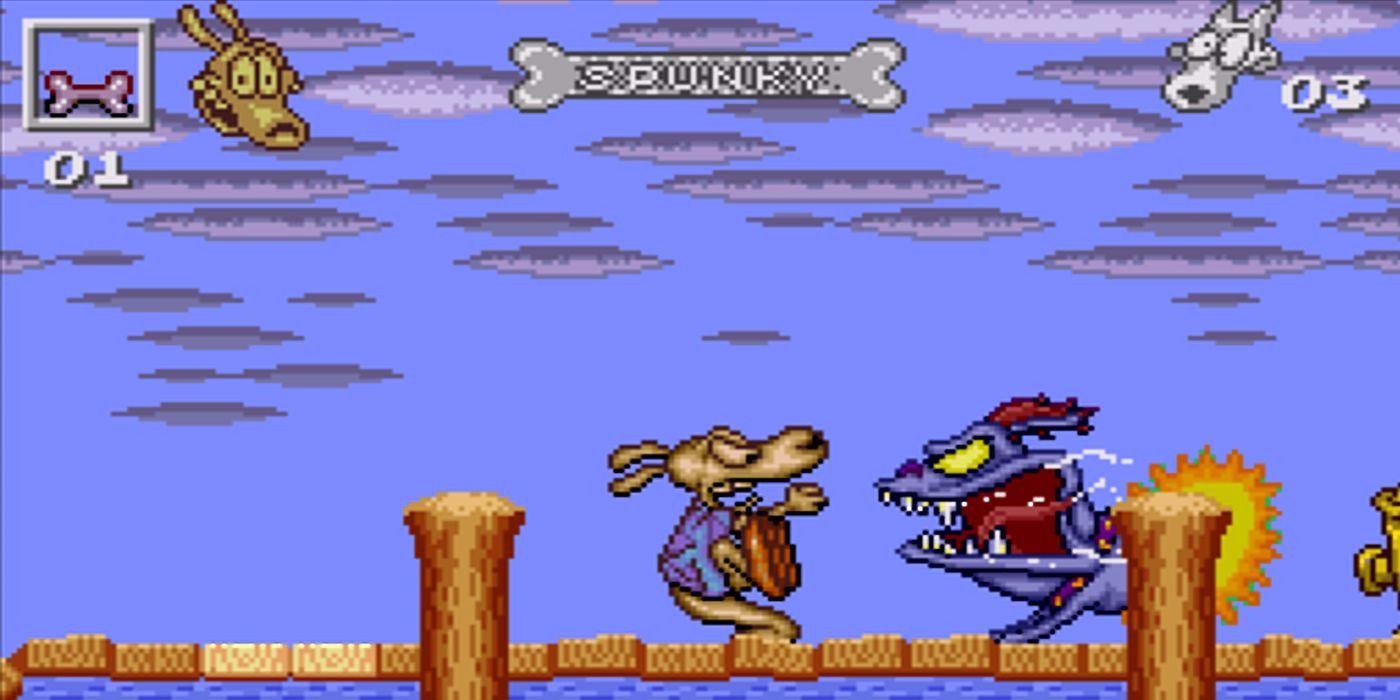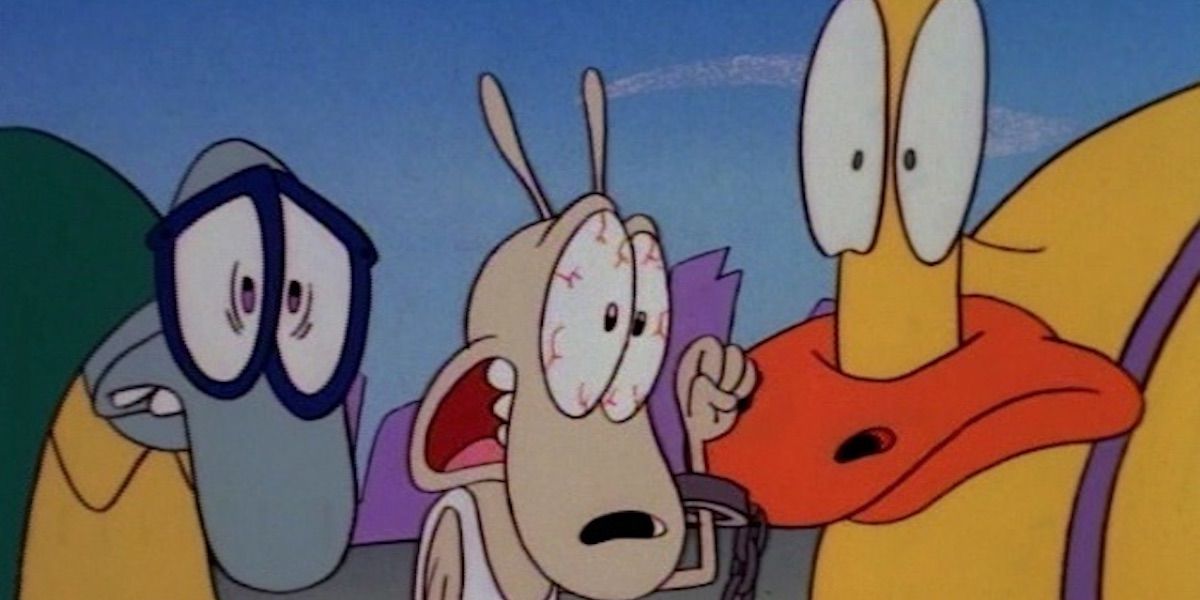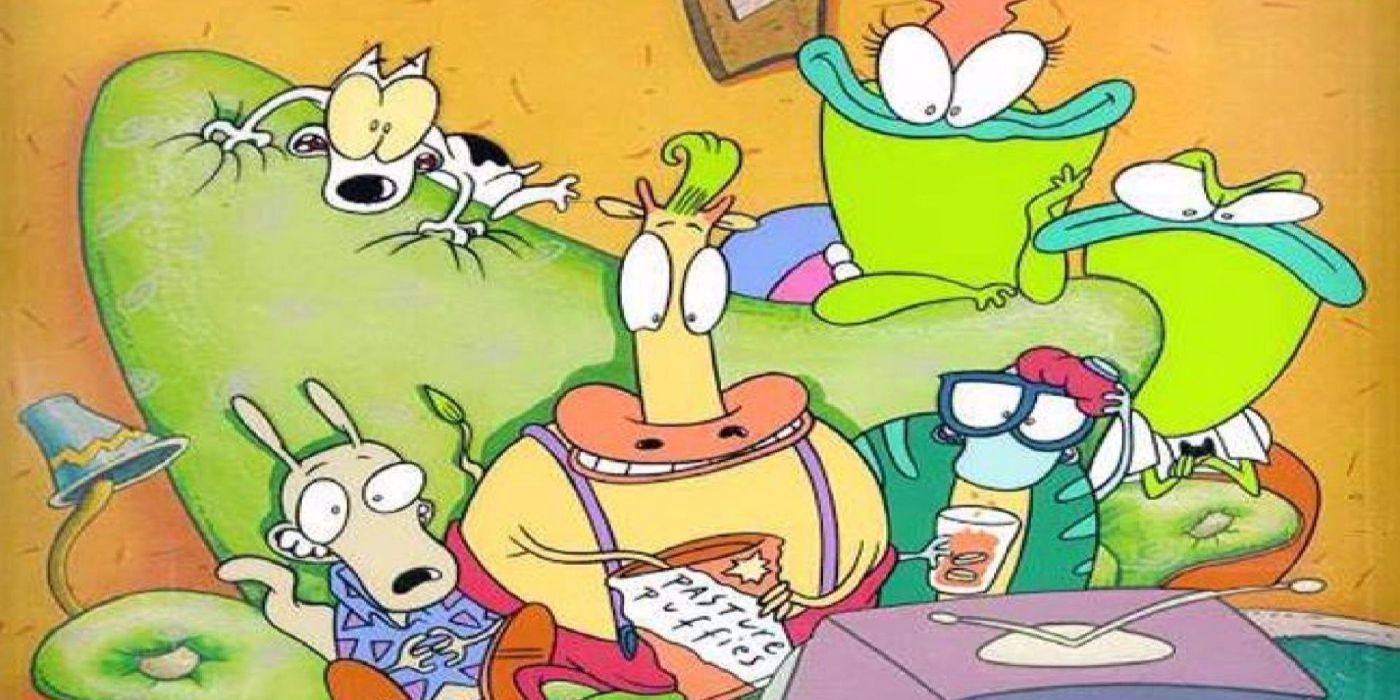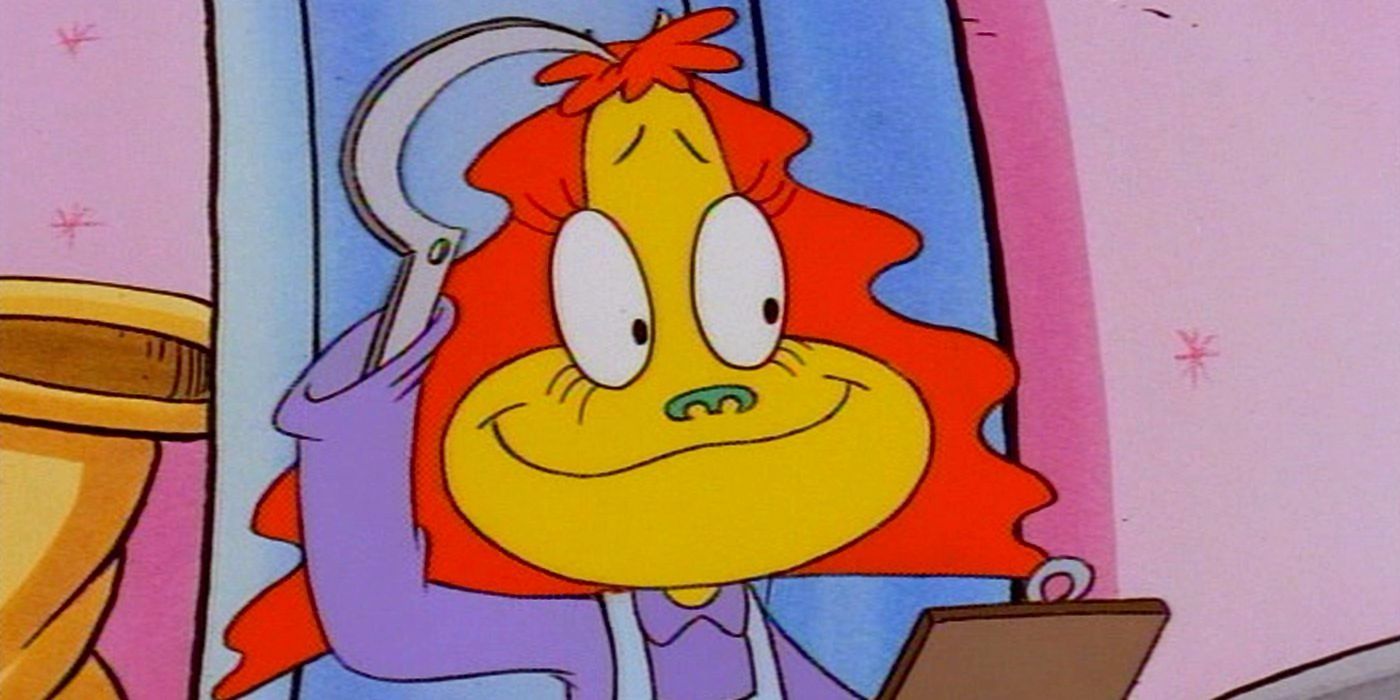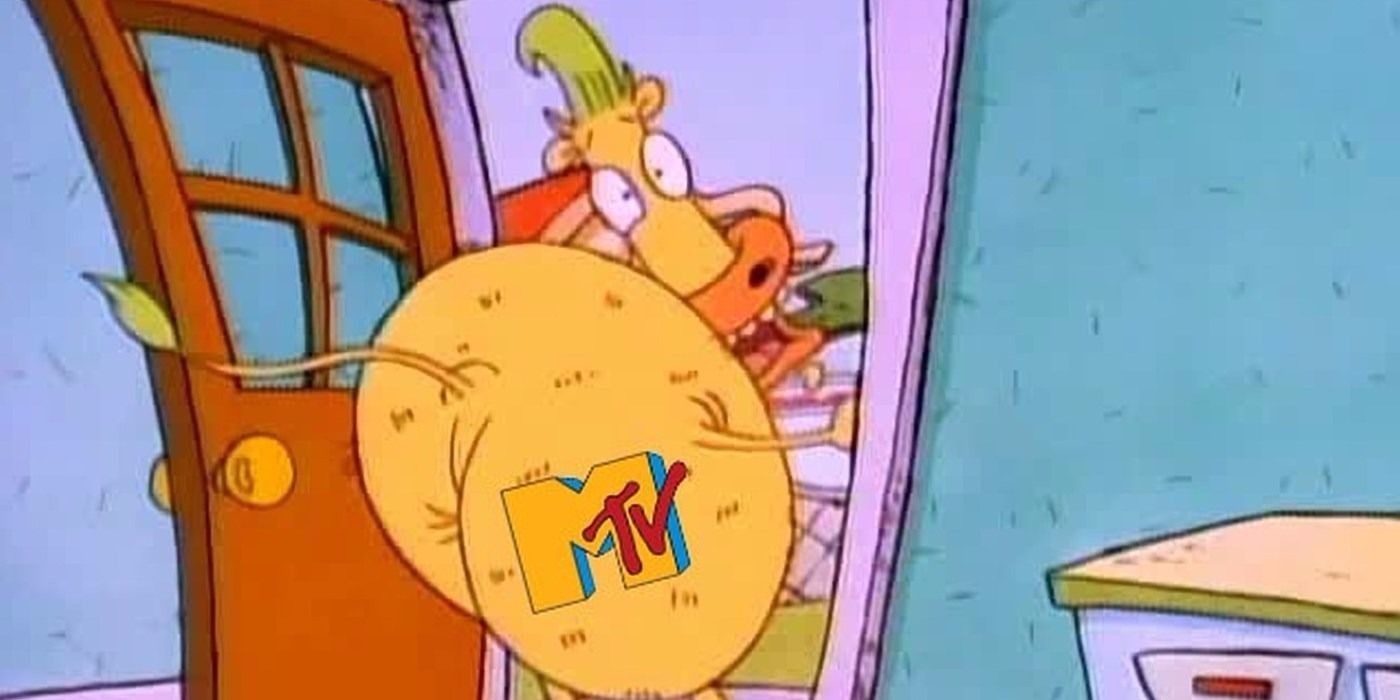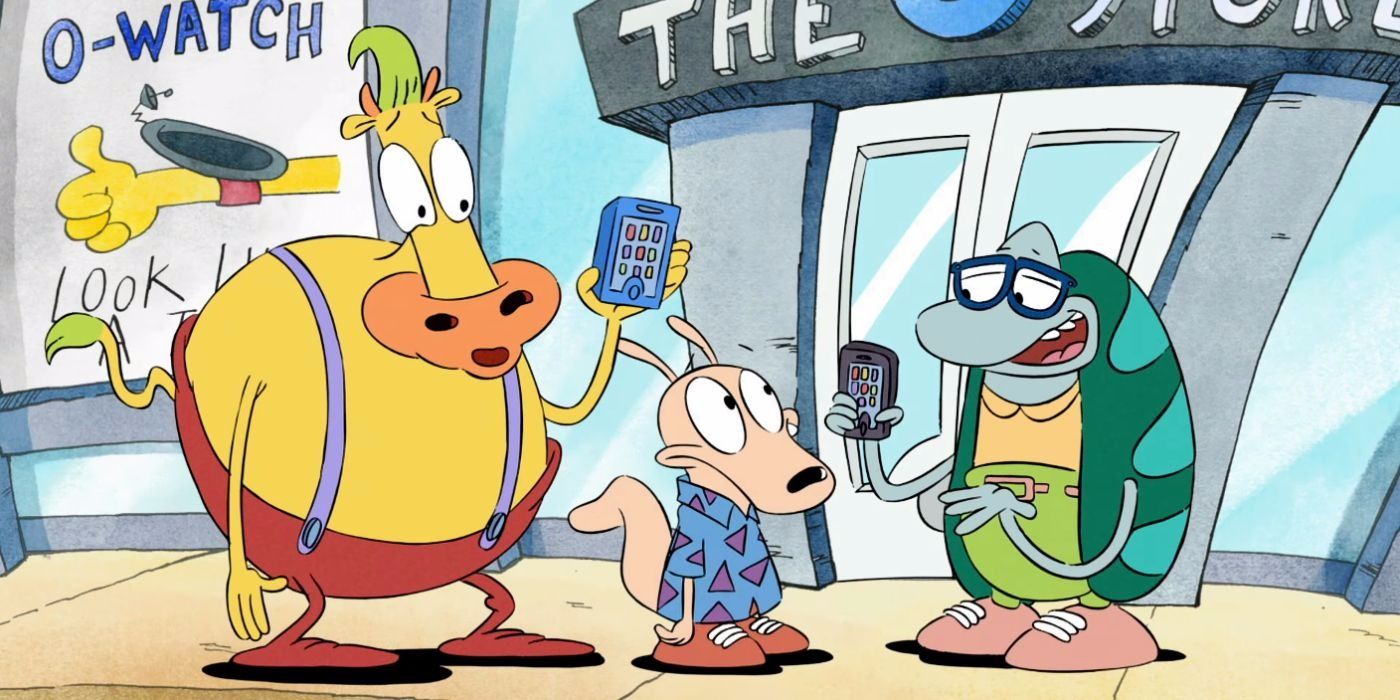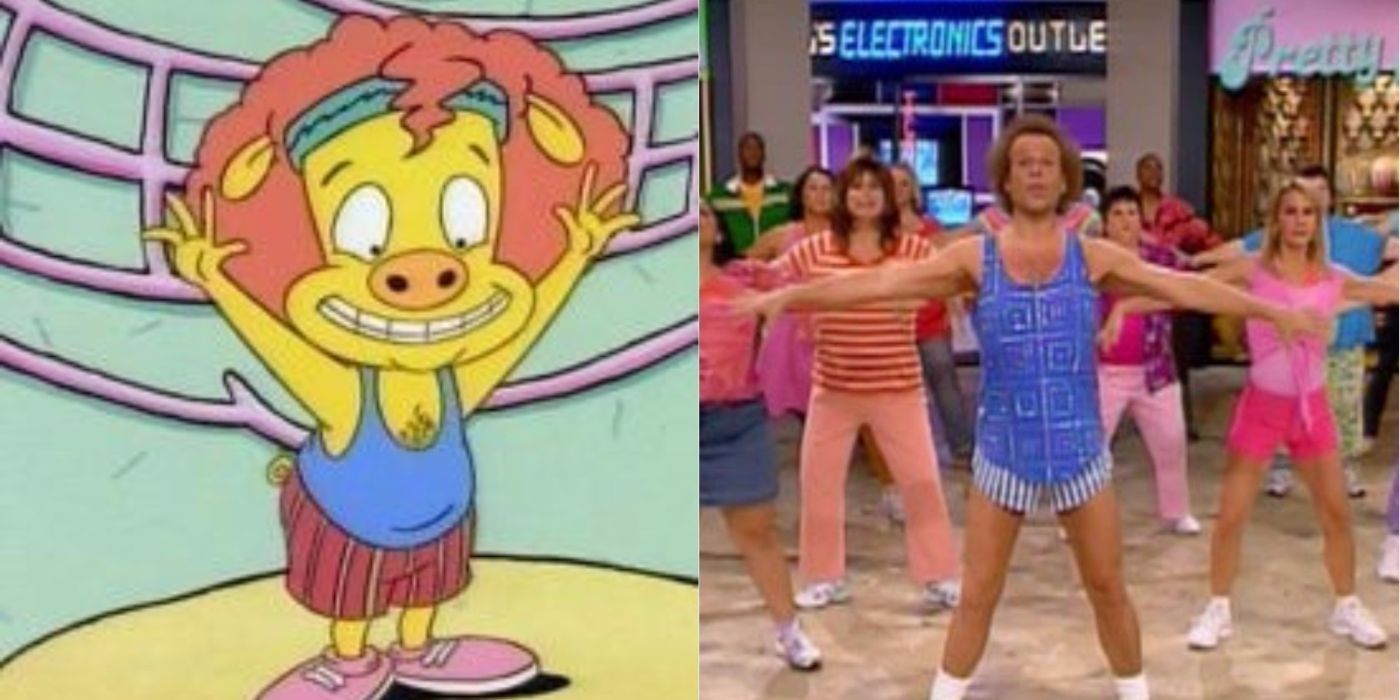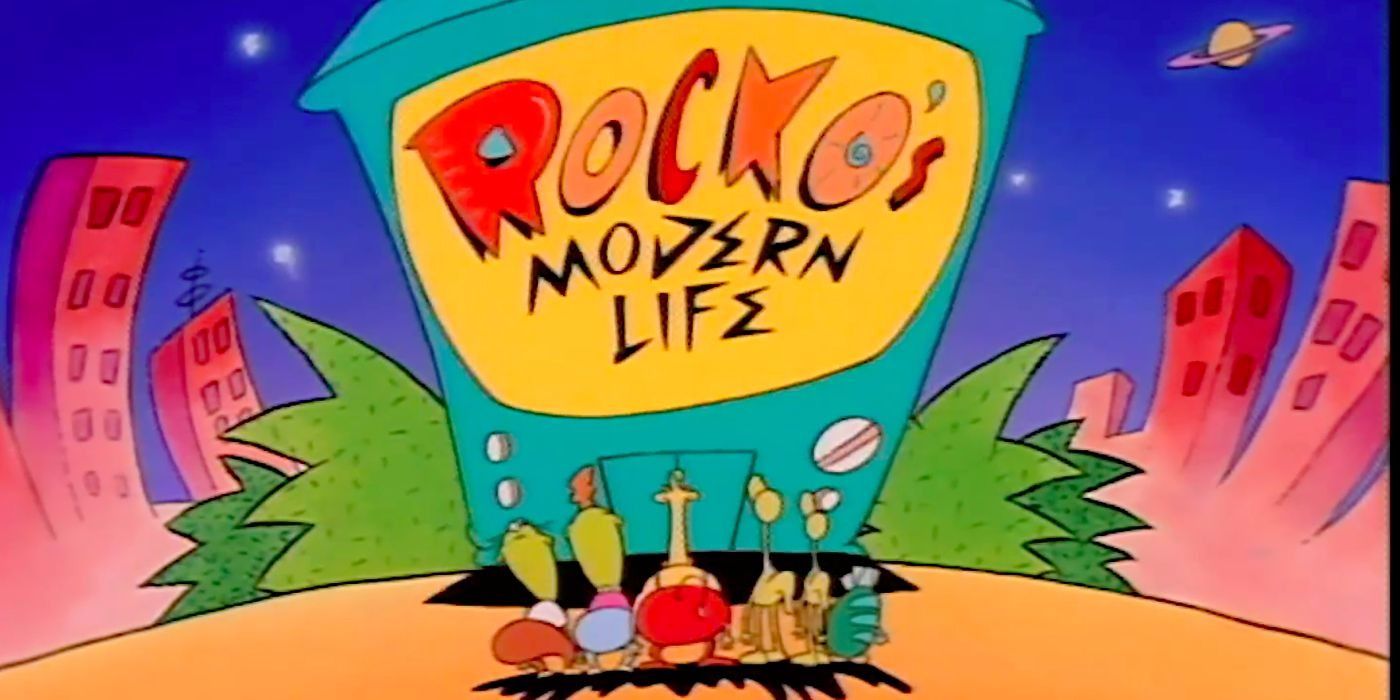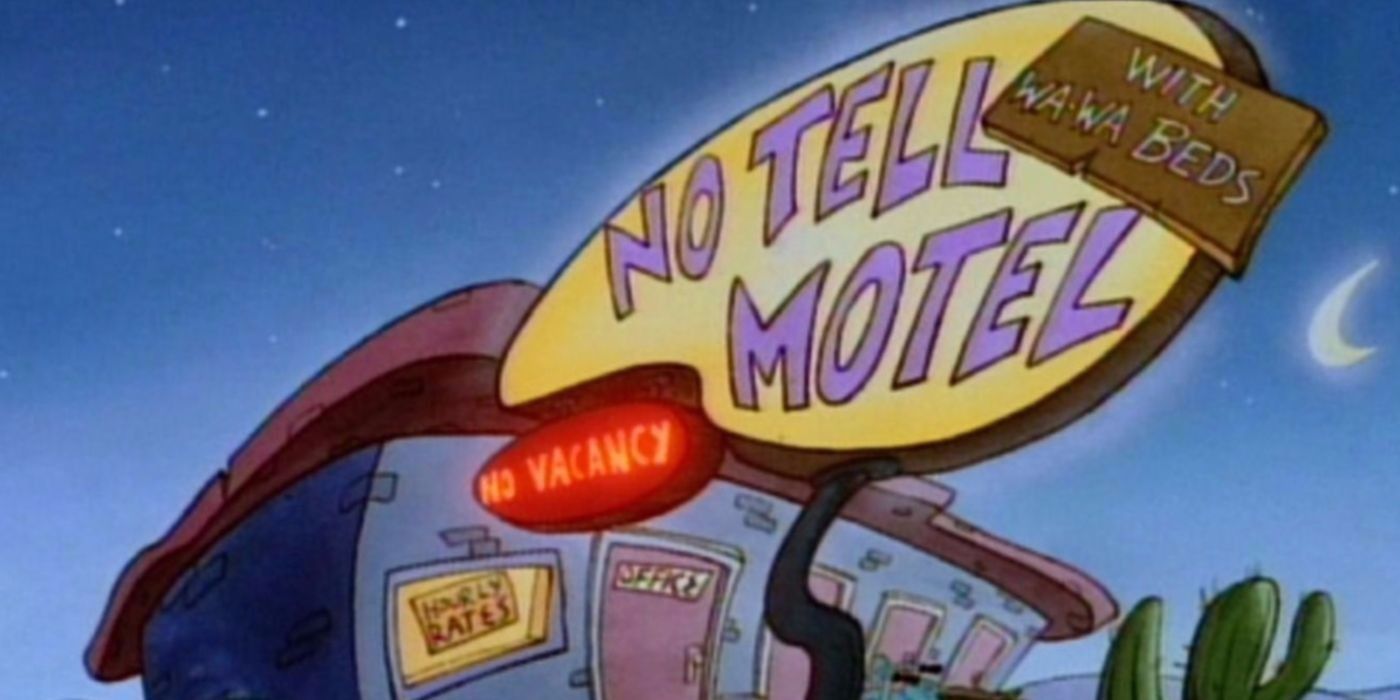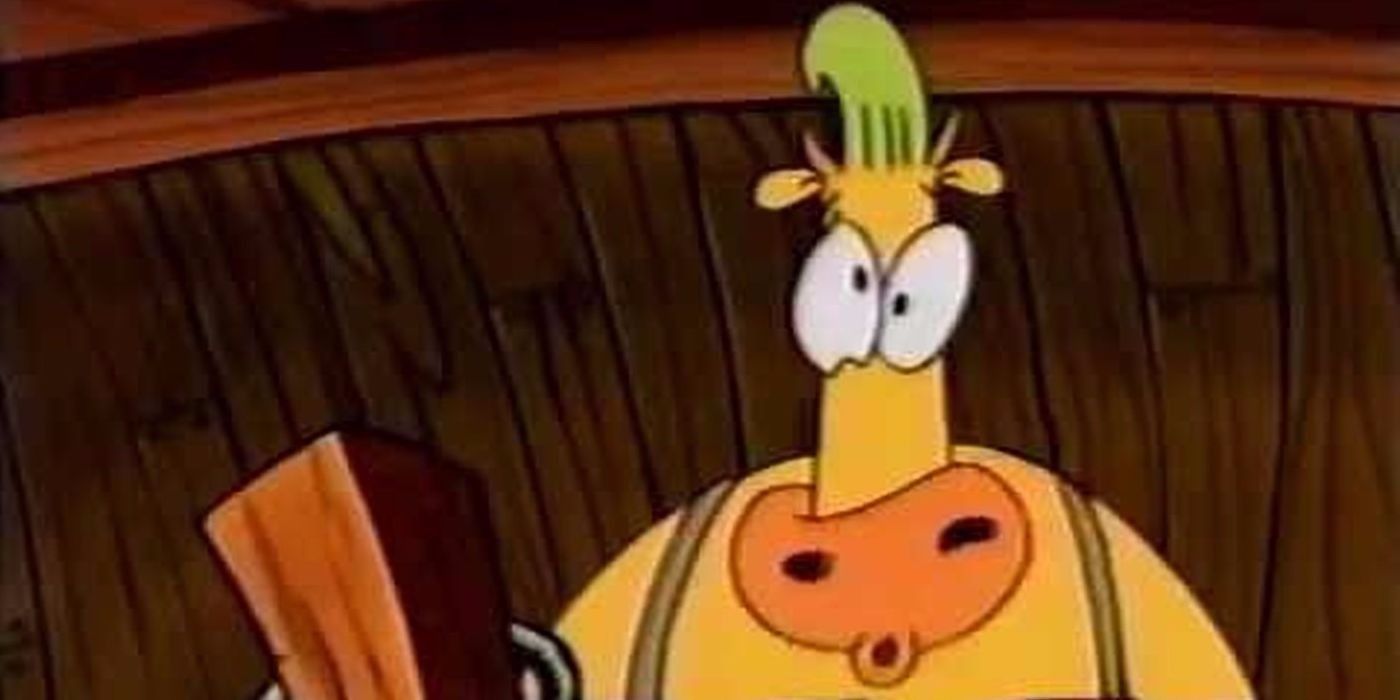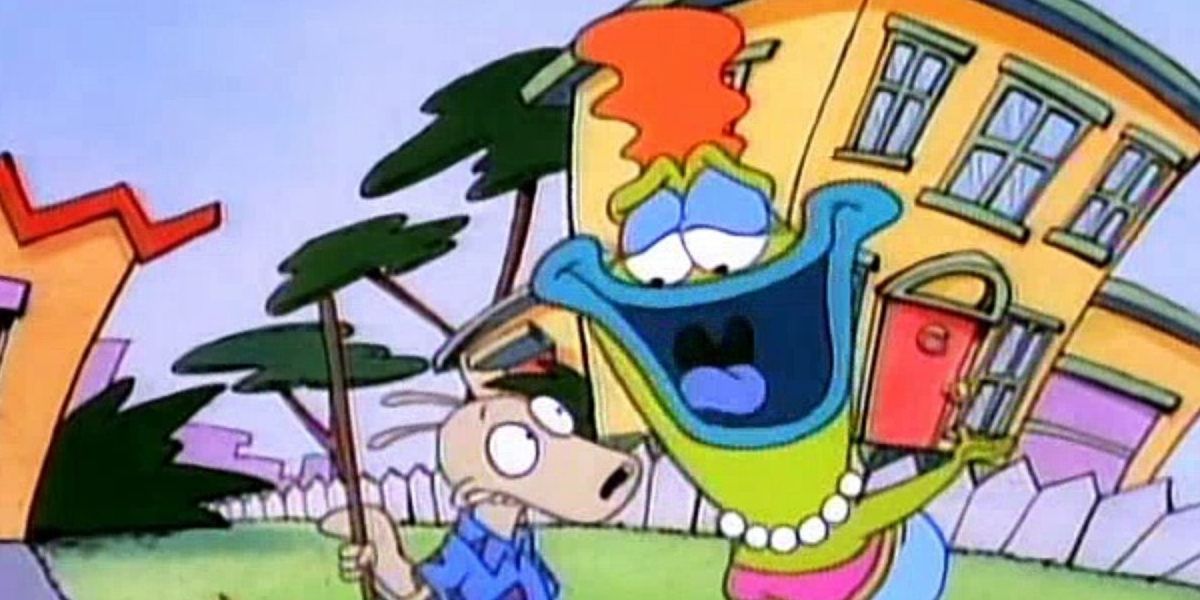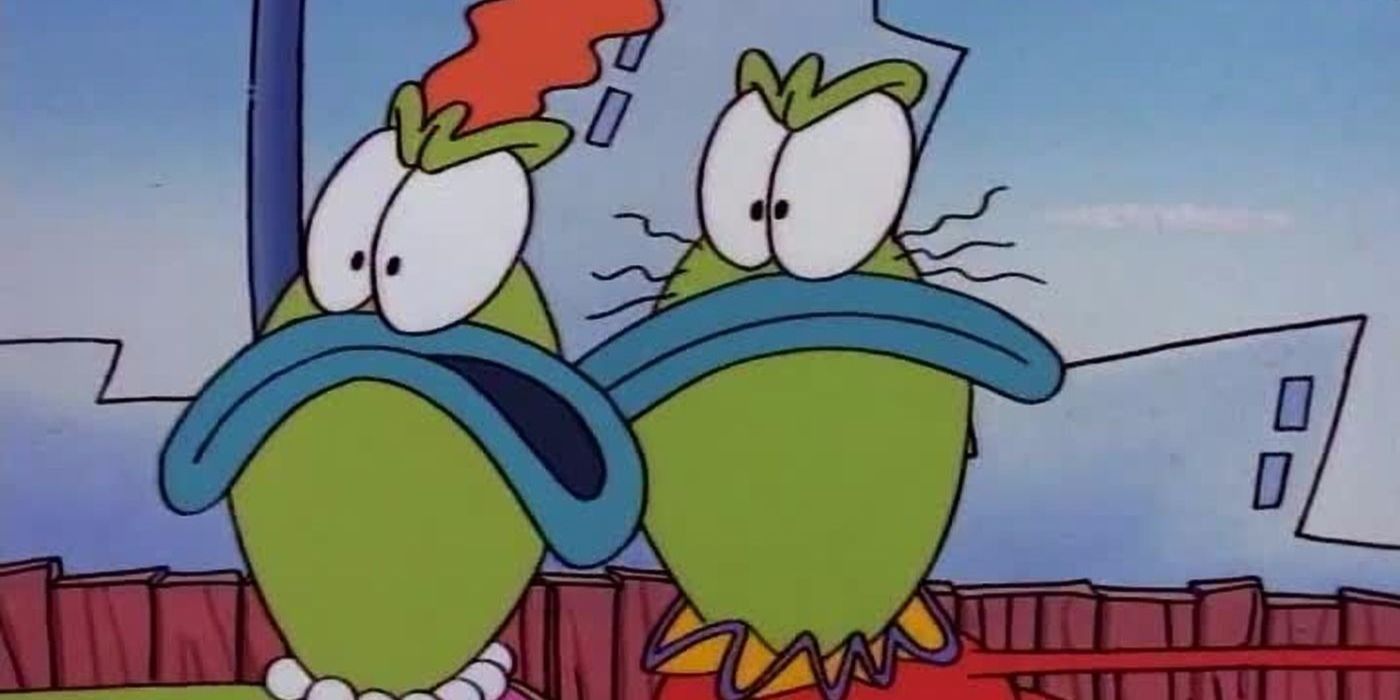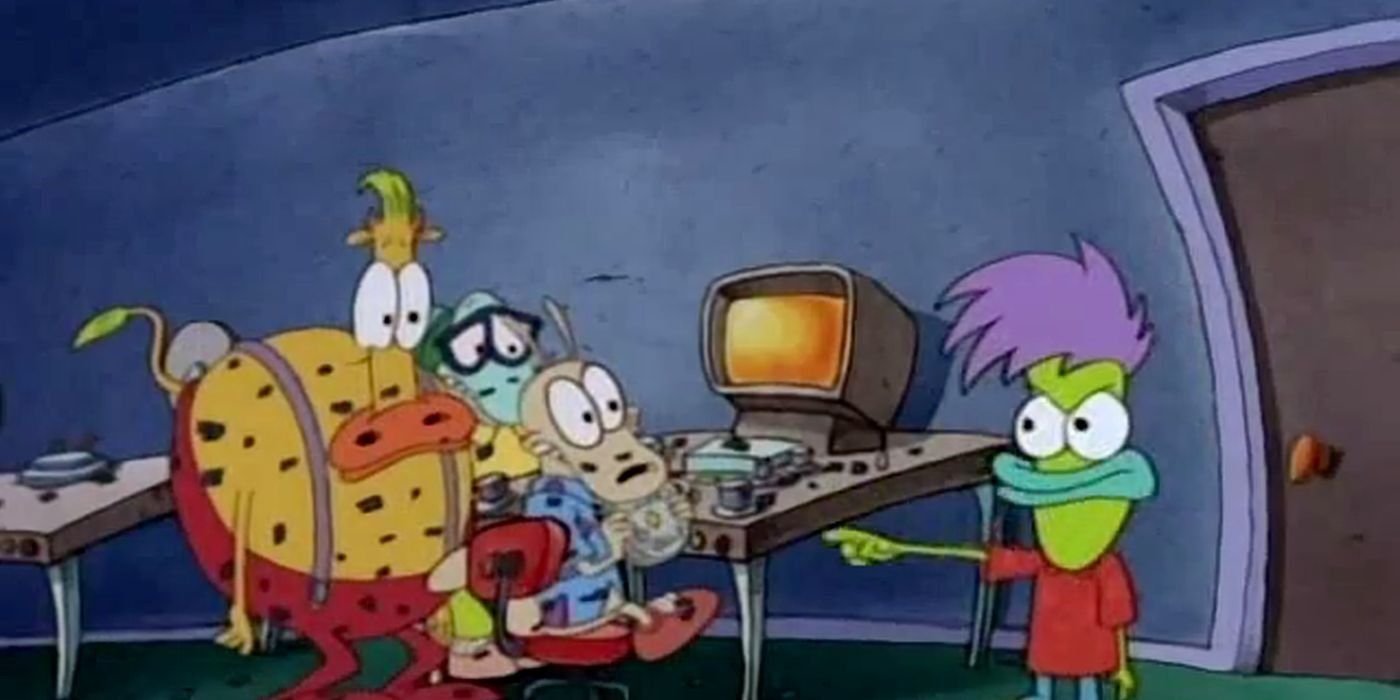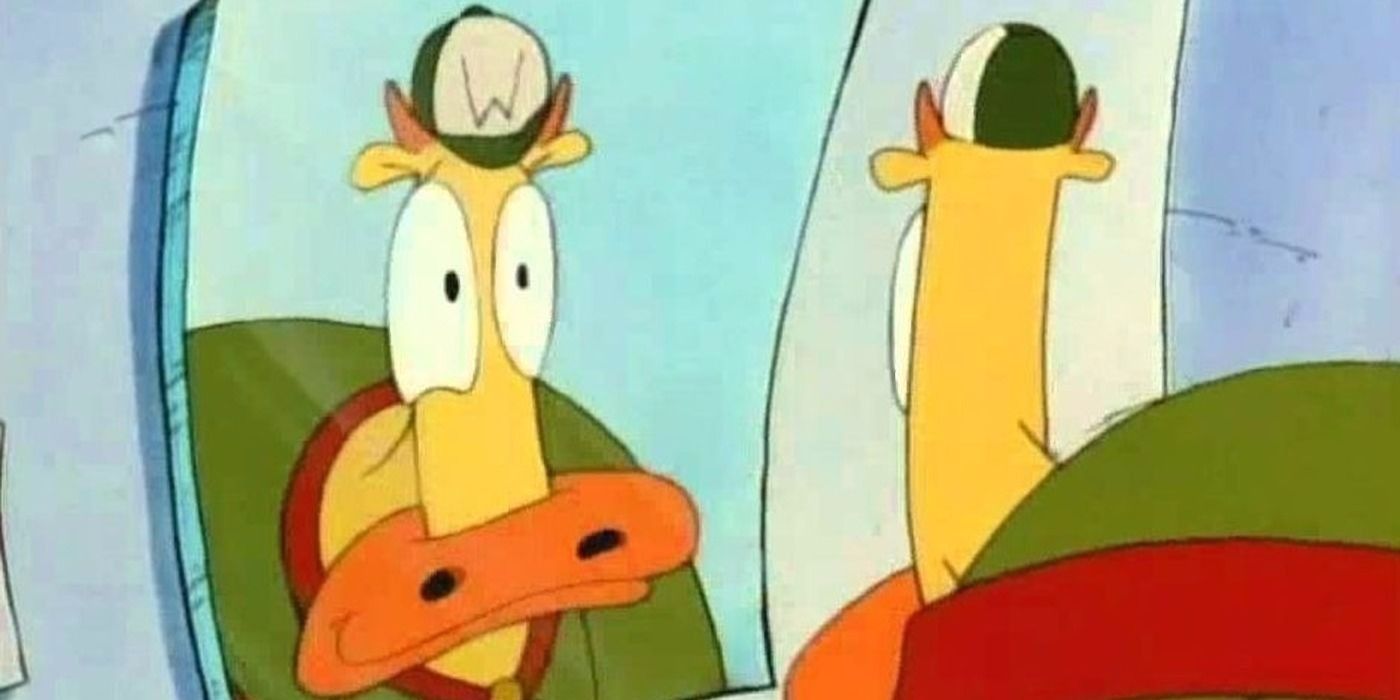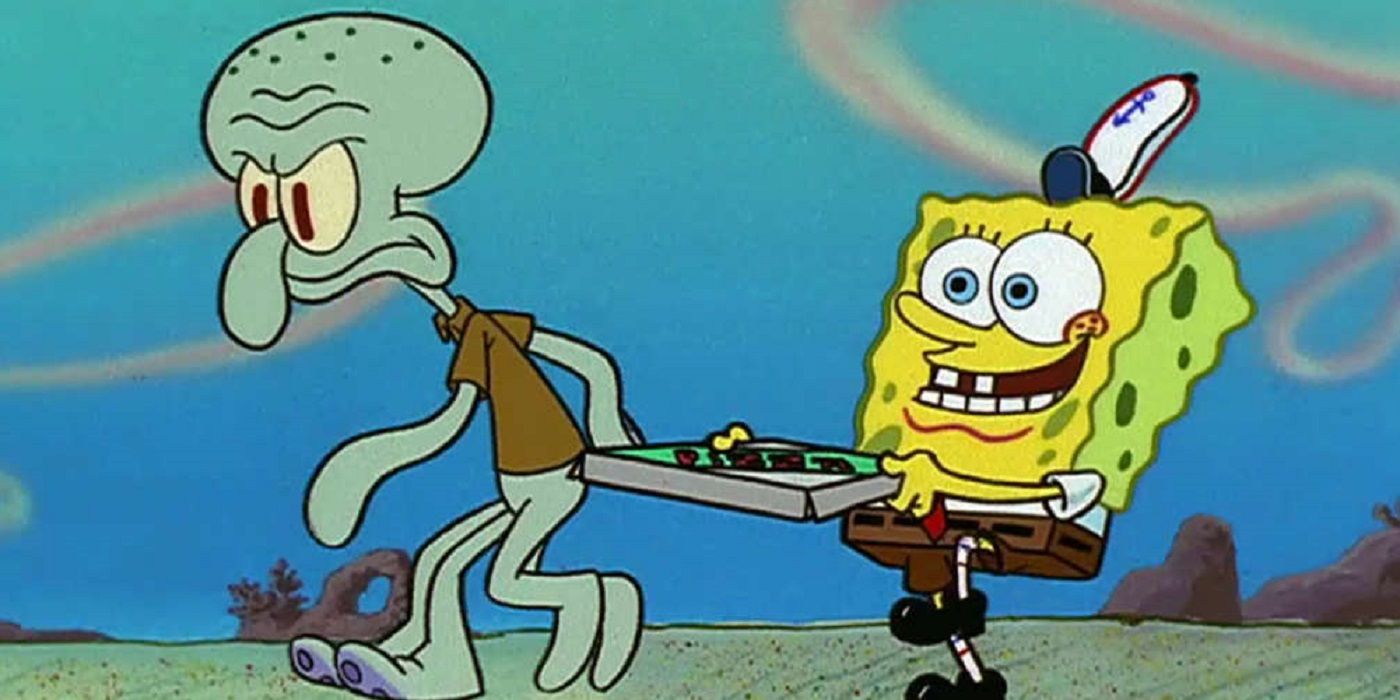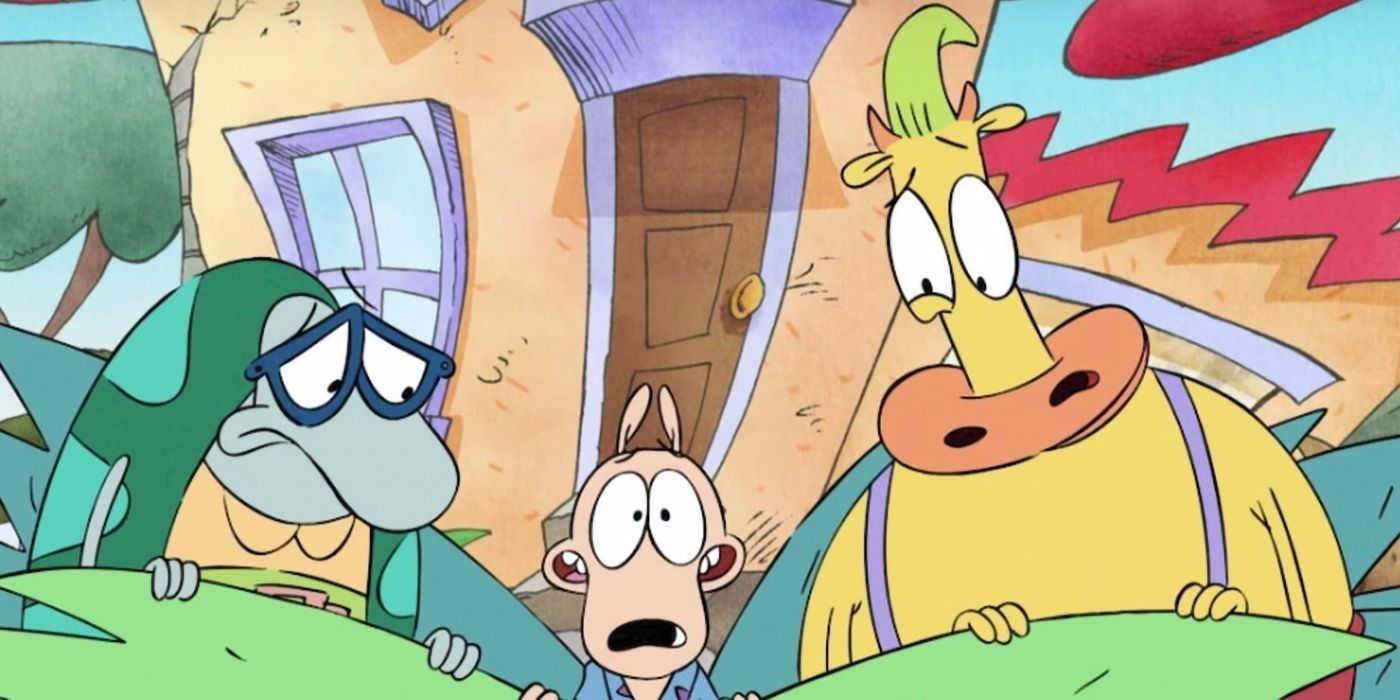Joe Murray never originally intended to make Rocko’s Modern Life into a cartoon series. The misadventures of the anthropomorphic Australian-immigrant wallaby named Rocko, set in the fictional world of O-Town, originally started life as an unpublished comic book series back in the late 1980s.
But with Nickelodeon eager to follow up on the success of Nicktoons animated series like The Ren & Stimpy Show, Murray was encouraged to pitch the show to the network. Studio chiefs evidently saw something in Murray’s premise, which tapped into the Nicktoons mantra for providing edgy animation that appealed to both kids and adults alike. Rocko’s Modern Life premiered on September 18, 1993, and soon developed a cult following, thanks to Rocko and his memorable cast of supporting characters. There was Heffer the comfort-eating steer, Filburt the neurotic Woody Allen-esque turtle, and Rocko’s faithful dog Spunky.
Rocko’s Modern Life was smart too, blending kid-friendly cartoon animation with biting satire, social commentary, and some surprisingly adult humor. Running for four seasons and 52 episodes, Rocko’s Modern Life has retained a cult status matched by few other series and helped pave the way for similarly surreal animated shows like Spongebob Squarepants, which actually featured some of the same voice actors and animators.
The show wasn’t without the occasional moment of controversy during its run though – here are 18 Things You Never Knew About Rocko’s Modern Life.
18. The Chokey Chicken
Every good gang needs a hangout, and for Rocko, Heffer, and Filbur, that safe social space came in the form of the Chokey Chicken, a fast food restaurant parody of the real-life Kentucky Fried Chicken and a place where the group regularly fraternized.
A key component of O-Town – itself a parody of generic American living - the name Chokey Chicken came with some pretty adult connotations given that the phrase "to choke the chicken" is a familiar slag term for masturbation. It didn’t seem to bother Nickelodeon all that much though, with the name staying in place for the first three seasons of Rocko’s Modern Life.
Someone at the studio evidently caught on by the time the fourth season of the show came along, however, with the name Chokey Chicken quietly being replaced with Chewey Chicken.
Rocko Changed Color
The original pilot episode of Rocko’s Modern Life features a noticeably different version of its wallaby protagonist. Produced at Joe Murray Studio in Saratoga, California, the pilot version of "Trash-O-Madness" saw Rocko scrambling to gather up rubbish before the garbage man arrives, and featured a noticeably yellow Rocko.
The pilot not only piqued the interest of Nickelodeon, but also a major toy manufacturer. They approached the network with a proposal to create a line of Rocko’s Modern Life toys, but had one very specific condition: Rocko had to change color. It seems the company involved already had a line of yellow-colored characters and wanted to avoid confusion. From the second episode onwards, Rocko was a much paler tone.
Unbelievably, after all of that, the toy manufacturer involved – which remains unknown – backed out of the plans, though Rocko’s new look remained.
Rocko’s Modern Life Was A Computer Game First
Toy manufacturers were not the only ones to see the potential in Rocko’s Modern Life, with game developers similarly keen on the idea of creating a title involving the lovable wallaby. The key difference was that while that initial interest from toy makers came to nothing, a computer game chronicling the adventures of Rocko was actually being developed before the cartoon even went into production.
Rocko's Modern Life: Spunky's Dangerous Day was a two-dimensional side-scrolling platform game released in April 1994 on the Super Nintendo Entertainment System, featuring several levels based on familiar episodes of the show. It took just under a year to develop and was remarkable for being based almost entirely on concept sketches rather than an actual cartoon. That is part of the reason why the game ended up looking noticeably different to the animated series. It nevertheless scored solid reviews at the time of release.
Rocko’s Surname Was Never Revealed On The Show
In the original comic strip conceived by Murray, Rocko was actually called Travis and based on a real-life wallaby Murray encountered at the zoo. Murray only switched the character name to Rocko because he felt it made him sound more like a fighter. Rocko’s surname was never revealed on the show, however, and it became something of a running gag.
It’s unclear whether this was a deliberate move, like The Waitress on It's Always Sunny In Philadelphia, with Murray playing on the fact that it was never revealed. It may have simply been deemed irrelevant to the proceedings. In any case, Rocko did eventually get a surname, which was revealed in the Jerry Beck book, Not Just Cartoons: Nicktoons! He was born Rocko Rama, or Rock-O-Rama, in reference to Murray’s penchant for adding O's to the titles of pretty much everything on the show - a comment on America’s habit of homogenizing almost everything.
Rocko Originally Had A Sister
The original incarnation of Rocko’s Modern Life was markedly different to the one that made it onto Nickelodeon. In the original presentation to the network, Murray outlined his vision, which included the idea that Rocko had a sister named Magdalane with two infant kids.
But when it came time to make the show, Murray had a change of heart, believing Rocko worked better without a sibling. By the time season two came along, Murray looked set to reverse his decision, after writing an episode entitled "Wake Up Maggie" which introduced Rocko's sister as a narcolepsy-suffering wallaby. The script was not well received by Nickelodeon executives, however, and her introduction was once again stalled.
Later, when Murray began facing questions from the press over the lack of female role models on the show, Nickelodeon executives suggested introducing the character as a means of appeasing the criticism. He responded by dropping her altogether, hoping to send a message about interference to the network.
Dr. Paula Hutchison Was A Protest Character
Already under pressure to include more female role models in Rocko’s Modern Life, Murray decided to ditch plans for Rocko’s sister Magdalane in favor of something a little more on the nose. At the time, Nickelodeon executives were eager for the show to feature a positive female character, with one suggesting they create "a professional woman, someone with a good hook."
Murray and his team opted to take the instructions as literally as possible, and the result was Dr. Paula Hutchison - a feline dentist who literally had a hook for a hand. The story went that Dr. Hutchison lost her hand while performing a check-up on a crocodile patient. As time went on, those working on the show grew to love the character, resulting in the episode "The Big Question", which defied Nicktoons rules by having Dr. Hutchison marry Filburt. Linear character development was unheard of in animation at the time.
Heffer’s Started Out On MTV
Heffer’s existence actually pre-dates Rocko’s Modern Life – the character previously featured in a 1989 MTV spot by Murray, which saw the steer character branded with the channel's iconic logo. Rocko’s food-loving best friend was actually based on a real-life person, too. Murray claims to have been inspired to create the character based on an old school friend who genuinely loved bologna sandwiches and, like Heffer, was adopted.
His friend’s experience and emotional response to being adopted also helped Murray when it came time to tackling the issue on the episode “Who’s For Dinner” from the show’s first season. Tom Kenny, who provided Heffer’s voice on the show, also found inspiration from a surprising source: his 13-year-old nephew, who provided the basis for what became Heffer’s distinctive vocal approach to the character.
Filburt Was A Happy Accident
Filburt may have ended up playing a prominent role on Rocko’s Modern Life, but that wasn’t exactly the plan when Murray first started putting the show together. Viewed as a secondary character on the series, Murray initially struggled to cast a suitable voice actor for the part, listening to audition after audition with no luck.
David Lawrence, or Mr. Lawrence, as he is more commonly credited, had already been hired as an artist and director, but felt he had something to offer when it came to voicing the turtle character, discreetly submitting an audition tape of his own. When Murray heard it, he was immediately sold and delighted to discover that it was Lawrence who provided the voice. Mr. Lawrence’s take proved so popular that Filburt ended up with an expanded role on the series.
Richard Simmons Had A Cameo
Richard Simmons may be a man of mystery these days, but back in the early 1990s, he was only too happy to get involved in any number of unusual projects – including providing one of the voices on a subversive new cartoon series on Nickelodeon.
The season one episode "No Pain No Gain" saw Simmons make a guest star appearance as an aerobics instructor. Simmons lent his voice and likeness to the unnamed character, who runs a fitness session at the exclusive exercise clinic Rocko and Heffer Wolfe join at the start of the episode.
Despite references to Simmons in popular animated series like The Simpsons and Family Guy over the years, Rocko’s Modern Life remains his only animated TV credit to date, save for a voice appearance on the animated film Rudolph the Red-Nosed Reindeer: The Movie.
The B-52s Sang The Theme Tune
Theme tune king Danny Elfman was originally approached to do the intro song for Rocko’s Modern Life, but ultimately had to turn down the offer, as he was busy working on another project at the time. The show did eventually get a big name to record the now-familiar theme tune though: The B-52s. Fred Schneider and Kate Pierson, the two lead vocalists from the group, ended up singing the show’s theme tune from season two onward, with their recording used right up until the conclusion of the series after four seasons.
Around the same time, the B-52s also contributed a song to another notable soundtrack, this time for The Flintstones Movie, starring John Goodman and Rick Moranis. Their work on Rocko’s Modern Life was the better received of the two efforts, though.
"Road Rash" Had A Joke About Prostitutes
Rocko’s Modern Life may have been known for its adult humor, but there were plenty of occasions where the show made things a little too adult, if you know what we mean. The episode "Road Rash" is a prime example. When Rocko and Heffer discover Flem Rock is about to be bulldozed, they decide to head off on a road trip to see it one final time.
Along the way, the pair stop off at the No-Tell Motel for the night, a motel offering “hourly rates” according to an advert visible when they first arrive. If Murray and his team had left it there, they might have got away with it, but they decided to ramp it up further when Rocko and Heffer go to the front desk to get a room.
"All night?" The character at the front desk replies, with obvious surprise. "Whee-ooo! Okay." The scene was subsequently removed from future broadcasts in the US.
Several Milking Scenes Had To Be Cut
"The Good, the Bad and the Wallaby" was another episode that veered dangerously close to adults-only territory at the time. In the episode, Heffer and Rocko visit a local farm as part of a trip that eventually inspires Heffer to go native. The episode’s one moment of controversy came early on, when Heffer first encounters a milking machine in a scene where viewers only see the steer’s reactions while alluding to the fact that something sexual is going on.
Initially, Nickelodeon were happy to include the scene, despite the sexual connotations, with the one key change being that stars, rather than hearts, appear in Heffer’s eyes. Ultimately, however, both that scene and a later one that sees Heffer end his relationship with the milking machine, were both removed from the episode. Oddly, the scenes stayed in the version aired in Canada, though.
The Show's Third Episode Was Banned
Rocko’s Modern Life never shied away from tackling adult themes, though the executives over at Nickelodeon must have wished they did on occasion. "Leap Frog" was only the third episode in the first season of the show, but it still ranks among the most contentious, given that it tackles the twin topics of infidelity and consent in a strange, yet ultimately amusing, way.
Feeling unloved by her husband Ed, Bev Bighead decides to invite Rocko over to her house so that he can do a few chores for her. Once there, however, things take an unexpected turn, with Bev attempting to seduce the titular Wallaby to get back at her ignorant husband. With much of the episode taken up by Bev Bighead relentlessly pursuing Rocko, it wasn’t long before the complaints from parents started rolling in. Nickelodeon subsequently banned the episode after a second airing. It has since been reinstated to Nicktoons TV and features on all the DVD releases to date.
The Inspiration For The Bigheads
Ed and Bev Bighead were two other characters seemingly inspired by real-life people that creator Murray came into contact with earlier in his life. This time around, the inspiration behind the married couple was supposedly a pair of grouchy neighbors Murray had the misfortune of growing up next door to.
He evidently doesn’t have fond memories of the couple, with the pair shown to be angry, difficult, and even borderline masochistic on the show (Bev actually sleeps on sharp objects). The decision to make the Bigheads cane toads came as a result of a crisis Murray’s home nation of Australia was having with the amphibian animals around the time Rocko’s Modern Life was being developed for Nickelodeon. Murray also took inspiration from his mother to create Bev’s distinctive bouffant hairstyle, which was similar to one she rocked back in the 1960s.
Several Episodes Were Inspired By Real-Life Experiences
Some pretty notable episodes of the series were inspired by real-life experiences. The second season opener “I Have No Son!” introduced Ed Bighead’s Son, Ralph, who was estranged from his family after choosing to become a cartoonist rather than a corporate man like his father always hoped, and was based on Murray's own fractious relationship with Nickelodeon.
Ralph then returned for the third season two-parter "Wack Delly". Eager to leave the television animation industry but forced to create a new show, the episodes saw Ralph hire Rocko, Heffer, and Filburt to create the new series, thinking they will mess it up. The show becomes a hit, however, and Ralph is forced into extreme measures to sabotage it. The episode, in particular, is thought to have been inspired by Murray's desire to leave Nickelodeon at the time.
The episode "Bye, Bye Birdie" was also inspired by the experience of writer George Maestri, who once babysat a friend’s bird when he was 12, only for the pet to die on him.
Making A Belch Of Destiny
The "Belch of Destiny" ranks among Murray’s favorite episodes of Rocko’s Modern Life, and focuses on Heffer and his unique talent for “belch talking” – something which greatly displeases his adoptive father on the show. While creating the episode, Murray and the writers got wind that David Pritchard, a former Warner Brothers producer whose credits include Comrades of Summer, was capable of recreating the burp speech they needed for the episode.
After an initial audition, Pritchard was brought in for an official recording session, where he was plied with beer, spaghetti, and even an extra spicy burrito to prepare. Unfortunately, he was unable to belch on the spot. He did eventually record for the show in private, with segments from those recordings, as well as his initial audition, used in the series.
Rocko Paved The Way For Spongebob
When Rocko’s Modern Life finally went off the air in 1996, several notable members of the cast and creative team found their way onto Spongebob Squarepants. Spongebob creator Stephen Hillenburg decided to pursue a series centered on the deep sea character immediately after Rocko finished, along with a little help and encouragement from fellow Rocko’s Modern Life writer Martin Olson.
Much like Rocko’s Modern Life, Spongebob Squarepants actually first featured in an unpublished comic book from the late 1980s, which Hillenburg was later able to turn into an animated series. Other creatives who worked behind the scenes on Rocko’s Modern Life before moving on to Spongebob Squarepants include Alan Smart, Derek Drymon, Nicolas Carr, and Nick Jennings, while the vocal talents of Tom Kenny (Heffer/Spongebob) and Doug Laurence (Filburt/Plankton) were also brought on board for the series.
Spongebob may have played it safer, but it kept the same subversive style and inventive characters as Rocko, albeit in a markedly different setting.
Working on Rocko’s Modern Life Was LOTS Of Fun
Murray has always maintained that he ran a very relaxed workplace from his San Francisco studio while working on Rocko’s Modern Life, and that many of his former co-workers have told him it was the most fun they ever had. While they may have had their run-ins with Nickelodeon, the team behind the show got on well, and seem to have fostered a fun atmosphere on the job.
Pranks were commonplace among co-workers, while children were welcome in the studio during work hours. Afternoon breaks were encouraged and workers would often be seen completing important tasks on couches in their pajamas. Spontaneous group sing-a-longs were also part and parcel of daily life. All this, and the show never missed a single production deadline.
--
Did we forget anything? Have your say in the comments!

